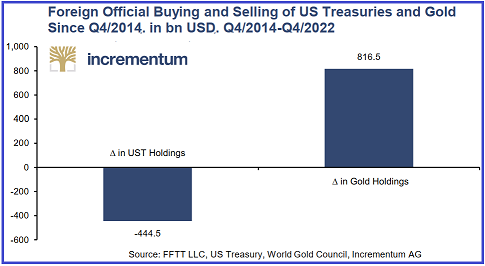Why the Stars Are Aligned for a Bull Market in Precious Metals
2023.10.27 03:43
I am firm in my conviction that the current market and political environment is quite similar to the third quarter of 2008. In that prior period of time, the financial system was headed toward a complete melt-down and the price of was mercilessly manipulated lower by western Central Banks in advance of the introduction of massive money printing, which was propitiously labeled “Quantitative Easing.”
While the rest of the financial system headed lower at the end of October 2008, the precious metals sector took off in a torrid bull cycle. The ensuing three years produced jaw-dropping investment returns. I believe that we are on the cusp of a similar move in the financial markets and the precious metals sector. The caveat is that I also believe, with a high degree of conviction, that the implosion of dollar-based financial assets will be worse than in 2008.
I recently spent a considerable amount of time examining, and trying to poke holes in, the precious metals sector investment thesis. The first concern is that perhaps the thesis that gold and represent both a wealth preservation asset and a total rate of return investment opportunity is wrong. That might be the case except that the price of gold (and ) is historically undervalued relative to financial assets (stocks and bonds). In isolation, this makes the sector an inordinate value investment proposition.
In addition, the major (and many “minor”) countries and Central Banks in the eastern hemisphere have been accumulating physical gold at a record rate on an annualized basis. Away from the well-known gold-accumulating countries, Turkey, Singapore, and Poland have been notably buying large quantities of gold this year. In addition to increasing the percentage of gold in their currency reserves, the biggest foreign buyers historically of U.S. Treasuries – China, Japan, and Saudi Arabia – have been reducing their Treasury holdings as well as reducing the amount of held in their respective reserves.
The chart on the next page from Incrementum’s 2023 “In Gold We Trust” report (with my minor cosmetic edits) shows the amount of Treasuries sold and gold purchased by official foreign entities (Central Bank primarily) between Q4 2014 and Q4 2022:

Buying and Selling of US Treasuries and Gold
The majority of this buying and selling has occurred over the last few years, with a record amount of gold purchased in 2022 by foreign Central Banks (predominantly Eastern hemisphere/Asian Central Banks).
Also consider that, away from Japan, the eastern alliance bloc of countries, which now includes Saudi Arabia, is working to advance a non-dollar trade settlement currency, thereby removing the dollar as the world’s only reserve currency. The Eastern hemisphere bloc of countries is thus clearly preparing for a world in which the reserve currency is not the US dollar. This is highly bullish for the precious metals sector. If this thesis is wrong, why have these countries been stockpiling large quantities of gold and “de-stocking US dollars?”
I thus conclude that the rationale for investing in gold and silver as both a wealth preservation asset and an alpha-generating rate of return investment is intact. But what about the constant effort by western Central Banks and Governments to suppress the price of gold as a means of preventing the gold price to act as a signal that official economic and financial policy implementation is headed toward catastrophic failure?
 LBMA vs Intraday vs Gold Chart
LBMA vs Intraday vs Gold Chart
Based on the information conveyed in the chart above from goldchartsrus.com (with my edits), the manipulation view is correct because it has been confirmed by the market. The chart segments the 24-hour trading period into the hours in which the eastern hemisphere bullion markets are open, with the Central Banks of those countries as well as the investor cohorts buying physical gold, which generally pushes the price higher, Conversely, during the trading hours in which the western markets are open and active, led by London and New York, very few investors are buying physical gold and silver and the price action is dominated by paper-based gold and silver derivatives trading action, which are used to drive the price lower.
The data used in the chart is what it is: actual point-of-trade price data derived from transactions in which ownership of physical gold bars is exchanged. Clearly, bona fide price discovery reflecting legitimate supply and demand for physical gold is corrupted when the Western markets take control of the trading price action in the precious metals sector using counterfeit derivative forms of gold that are traded digitally with complex computer systems and opaque standards of accountability.
Fortunately, it’s possible to manipulate markets only over short periods of time. Eventually “water finds its own level.” And just like the fourth quarter of 2008, I believe that the precious metals sector is percolating for a move that will end up being much bigger percentage-wise than the move from late 2008 to late 2011.
The trading action across all of the markets is quite similar to 2008 as is the economic environment. I’m certain that some type of credit market/banking system disruption is developing, similar to 2008, but that this time it will be more severe. Just like the collapse of Bear Stearns was the early warning sign that big problems in the credit market were unfolding – particularly in the derivatives markets, the collapse of the three big regional banks earlier this year is the market’s signal that bigger problems lie ahead. In addition, widespread political corruption along with economic and financial uncertainty in the U.S. and escalating global geopolitical instability has presented the perfect recipe for a bull market in the precious metals sector that should dwarf historical bull moves in the sector.








